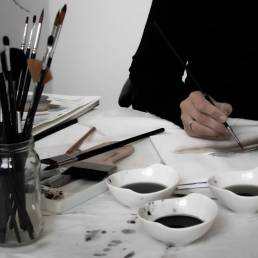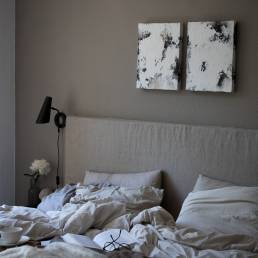art and wellness
It’s almost instinctive to associate art with wellbeing and healing, and it’s easy to suppose that art’s impact on wellbeing is simply aesthetic. Art does have a powerful impact on an environment and, by extension, on our experience of that environment. It can humanise a harsh, clinical hospital hallway or enliven a dull office, emphasising the human and social functions of sterile or functional environments. Humanising and beautifying an environment has the effect of reducing anxiety and depression while improving general happiness and productivity – even serving for some as an inspiration for meditation or quasi-religious psychic renewal.
So, art and wellness go hand in hand. There is growing scientific evidence that proves art can enhance brain function. It has an impact on our emotions, brain wave patterns, the nervous system and can actually raise serotonin levels which make us feel happier. This fast pace that we all are living, it is very important to stop and enjoy just a moment painting and do nothing else.
When we observe a profound piece of art, we are potentially firing the same neurons as the artist did when they created it, thus making new neural pathways and stimulating a state of inspiration. This sense of being drawn into a painting is called “embodied cognition” says writer J. Devsney.
Former editor R. Smith of BMJ also made a very interesting point – ‘if health is about adaptation, understanding and acceptance, then the arts may be more potent than anything that medicine has to offer’.
"Art holds out the promise of inner wholeness."
— Alain de Botton, writer

art gives purpose
Art can change our outlook and the way we experience the world. It can raise the spirits and strengthen the soul, it can help us make sense of our surroundings and change us and our society for the better.
Our wellbeing is first and foremost dependent on our emotional and mental state. Thus, creating interiors which support our overall wellbeing must include artwork that reflects the issues the inhabitant can understand and relate to. We can survive reasonably well in an interior that has no art, but it brings purpose, meaning and adds value to one’s life.
Including artwork in interior design doesn’t mean we have to spend considerable sums of money. We can easily find affordable pieces or art in a local market or side street, how much a piece costs should not define its’ real value to you. Digitalisation also allows many artists to publish print versions of their paintings that can be printed on either watercolour or canvas. I think it’s a great way to start bringing art into your home and doesn’t require a big budget.

art is therapeutic
The strongest link between art and wellness is of course in therapy. Philosopher Alain de Botton explains very distinctly how art benefits individuals and is often used as therapy:
- Helps with memory by seeing something as it is instead of receiving too much information all at once
- Makes us appreciate situations and life, by looking at what we already have which in turn increases our feeling of happiness.
- Deals with feelings of sadness and sorrow
- Gives us balance and perspective
- Guides us to grow by assisting in self-knowledge which help us be better people
We believe art should start a conversation rather than dull it, conflicting opinions on art should be celebrated not avoided. If we have an emotional response to a piece of art then it is a success! Perhaps the meaning of art and wellness is that it’s there to support us in our feelings and to help us rediscover our sense of self.
As you can see, artwork is more than just a painting or photography hanging on the wall. It is closely connected to our well-being and has a constant effect on us. Were you aware of this? Now it’s your turn: place art in your surroundings that is pleasant for you and learn to appreciate its positive effect on your body and mind. Have fun!
Looking for more art in Scandinavian style? Then definitely check out my Pinterest board “Art I love”!
Love,
